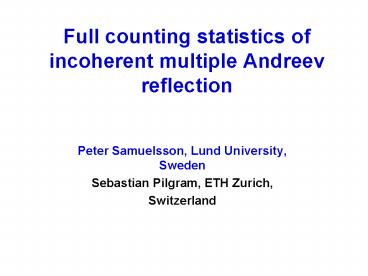Full counting statistics of incoherent multiple Andreev reflection PowerPoint PPT Presentation
1 / 22
Title: Full counting statistics of incoherent multiple Andreev reflection
1
Full counting statistics of incoherent multiple
Andreev reflection
- Peter Samuelsson, Lund University, Sweden
- Sebastian Pilgram, ETH Zurich,
- Switzerland
2
Outline
- Voltage biased Josephson junctions, multiple
Andreev reflections. - Coherent and incoherent transport.
- Noise and full counting statistics, stochastic
path integral approach. - Examples double barrier and diffusive wire
junctions. - Low voltage - energy space diffusion.
- Conclusions.
3
Josephson effect
Voltage biased superconducting tunnel junction
Josephson, Phys. Lett. 1, 251 (1962)
I
S
S
1
2
3
V
- Josephson current
- Dc-component
Cohen, Falicov, Philips, PRL 8, 316 (1962)
4
Subharmonic gap structure and excess current
Additional features in IV-curve
Cooper pair tunneling
Schrieffer, Wilkins, PRL 10, 17 (1963)
Taylor, Burstein, PRL 10, 14 (1963)
- Subharmonic gap structures
- Excess current
Van der Post et al, PRL 73, 2611 (1994)
5
Multiple Andreev reflections
Boltzmann approach (incoherent), weak link
Klapwijk, Blonder, Tinkham, Physica BC, 109-110
1657 (1982), Octavio, Tinkham, Blonder,
Klapwijk, PRB, 27 6739 (1083).
Klapwijk, Blonder, Tinkham, Physica BC, 109-110
1657 (1982), Octavio, Tinkham, Blonder,
Klapwijk, PRB, 27 6739 (1983).
S
S
e
h
V
Current
- Gives
- subharmonics
- excess current
6
Quantum point contacts
Coherent transport, single mode contact,
transparency D
Theory
Arnold, J. Low. Temp. Phys. 68 1 (1987). Bratus
et al, PRL 74, 2110 (1995). Averin, Bardas, PRL
75, 1831 (1995). Cuevas, Martin-Rodero,
Levy-Yeyati, PRB 74, xxxx (1996).
Atomic point contacts
Scheer et al, PRL 78, 3535 (1998). Scheer et al,
Nature 394, 154 (1998). Ludoph et al, PRB 61,
8561 (2000).
7
Noise multiple charges
Theory
Cuevas, Martin-Rodero, Levy-Yeyati, PRL 82, 4086
(1999),
Naveh, Averin, PRL 82, 4090 (1999).
Zero frequency noise
Fano factor
Experiment Cron et al PRL 86, 4104 (1999).
Quanta of multiple charge
Dieleman et al, PRL 79, 3486 (1997).
8
Full counting statistics
Full distribution of transported charge
- Long measurement
- time
- Charge
Cumulant generating function
Cumulants
non Gaussian
fluctuations
9
Coherent transport
Theory
Johansson, Samuelsson, Ingerman, PRL 91, 187002
(2003),
Cuevas, Belzig, PRL 91, xxx (2003) PRB xx, xxx
(2004).
Cumulant generating function
n-particle scattering probability
10
Incoherent transport
- Strong phase breaking suppressed
proximity effect
diffusive
ballistic
chaotic
Experimentally important regime (noise)
Jehl et al, PRL 83, 1660 (1999), Hoss et al, PRB
62 4079 (2000), Roche et al Physica C 352, 73
(2001), Hoffmann, Lefloch, Sanquer, EPJB 29 629
(2002).
Current and noise theory (incoherent)
Bezuglyi et al, PRL 83, 2050 (1999), Nagaev, PRL
86, 3112 (2001), Bezuglyi et al, PRB 63, 100501
(2001), Samuelsson et al, PRB 65, 180514 (2002).
No theory for full counting statistics!
11
Incoherent full counting statistics
Stochastic path integral approach, semiclassics
Pilgram et al, PRL 90, 206801 (2003), Jordan,
Sukhorukov, Pilgram, J. Math. Phys. 45, 4386
(2004).
- Separation of time scales Nagaev, xxxx.
- fast quasiparticle scattering,
- slow dynamics of distribution functions,
f
f
f
f
L
R
t
generalized Boltzmann-Languevin approach
Related approaches Kindermann, Beenakker,
Nazarov, PRB, xxxx, Bodineau, Derrida, PRL 92,
180601 (2004), Gutman, Mirlin, Gefen, xxxx.
12
Our work
Pilgram, Samuelsson, PRL 94, 086806 (2005)
Example ballistic SNS-junction, interface
barriers Octavio, Tinkham, Blonder, Klapwijk,
PRB, 27 6739 (1983).
h
N
S
S
S
e
Generating function, NS-interface
Muzukantskii, Khmelnitskii, PRB 50, 3982
(1994).
Andreev / normal reflection probability
Composed from elementary scattering probabilities
13
Stochastic path integral approach
- Formulate as path integral over
possible internal - charge configugurations
- Integrate out fast charge fluctuations
effective - generating function in slow variables
.
For
14
Saddle point equations
Semiclassical limit path integral in saddle
point approximation
Solution inserted back into
Cumulants
gives OTBK
(No simple expression...)
.....
15
Cumulants
Numerical evaluation, differential cumulants
- Subharmonic gap structure
- diverges at low
16
Probability distribution
Stationary phase approximation
With from
Conditional distribution functions
17
Low voltage limit
Low voltage limit , finite normal
back scattering
E
t
Quasiparticle diffusion in energy space
Generating function
Diffusive wire with renormalized charge
Jordan, Sukhorukov, Pilgram, J. Math. Phys. 45,
4386 (2004).
18
Generating function, saddle point solution
Low voltage cumulants , diverges for
......
Holds for large class of junctions, only
different
general incoherent low voltage behavior
Coherent junctions, diverges
for
Naveh, Averin, PRL 82, 4090 (1999), Johansson,
Samuelsson, Ingerman, PRL 91, 187002 (2003),
Cuevas, Belzig, PRB xxx
- Theory breaks down at , inelastic
scattering - cuts off divergence.
- Effect of environment not considered.
- Reulet et al, PRL xx, xx (xxxx), Kindermann,
Beenakker, Nazarov PRL ...
19
Diffusive wire
- Diffusive normal region
- Normal conductance
- Negligiable interface resistance
Recent experiments on third cumulant Reulet, Les
Houches.
20
Arbitrary voltage approach
2e
3e
For a voltage
Injection energies
- electron charges transfered
- Effective conductance
Injection energies
- electron charges transfered
- Effective conductance
21
Generating function adding up the two processes
First cumulants
Nagaev, PRL 86, 3112 (2001), Bezuglyi et al, PRB
63, 100501 (2001).
shows subharmonic gap structure
Excess generating function
22
Conclusions

